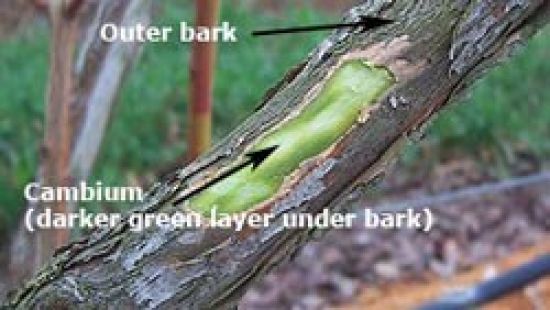This note provides information on factors to consider for recovery from fire damage in blueberry orchards.
Original Agriculture Victoria Note Number: AG1385
Published: September 2009, reviewed: July 2013
Introduction
Fire damage in blueberry orchards can affect plants in various ways, depending on intensity of the fire:
- Fruit is scorched, baked or damaged by ash
- Leaves are scorched and die, but branches survive
- Branches are affected by radiant heat, partially killing the cambium layer on the more exposed side
- Branches and leaves are burnt and die, but the crown is not killed
- Crowns and roots may be damaged through embers lodging on the base of the plant or in the mulch which can smoulder or ignite a new fire from the base.
- Crowns are burnt directly or by burning vegetation or mulch around the base of the plants
- Root systems are damaged by burning organic matter or heat in the root zone
- Root systems may survive even though the tops have been killed
- Irrigation lines and drippers are damaged or destroyed
- Netting is damaged or destroyed
- Ash may affect soil mineral composition and pH.
Although an orchard affected by fire and radiant heat initially appears devastated, affected blocks and plants may fully or partially recover. The extent of damage and crop loss, depends on the degree of heat generated by the fire passing over the crop, the time of year of the fire and the number of rows actually burnt out or damaged.
Assessing the damage

Figure 1. Dormant branch with bark scraped away to show cambium and sections of xylem (conductive tissue) underneath. (Photograph Courtesy of Professor Bernadine Strik)
The worst affected plants are most likely to be on the border/edge closest to the fire front.
Assessing the damage is not straight forward the branches, crown and roots can be blackened or brown and dry. It may take several weeks for symptoms to fully develop and fully assess the extent of the damage. Experience in both South Africa and Victoria has suggested that pruning the apparently deceased plants back to knee height and irrigating plants as soon as possible, gives the plants the best chance of recovery.
The crown and roots should be checked by scraping away some of the tissue from the crown and examining the roots. Live roots will show a creamy coloured centre when the bark is carefully scraped away. Healthy tissue in the crown or roots indicate that there is potential for the plant to survive and produce new whips.
Radiant heat and fire stressed plants may respond by reshooting or growing new shoots. If there is sufficient survival of stems, you may see a partial crop next season. Healthy leaves would normally be sending photosynthates to the crown and roots for storage in Autumn. Loss of leaves due to fire damage will prevent this process, weakening plant growth and potentially reducing the initiation of flower buds that happens in late summer/autumn.
A decision should be made as to how many plants have been killed outright to assess the viability of the whole block. Plants that are heavily damaged should be pruned to about 30 cm from the ground can encourage new shoot formation, but it may be a few years before there is a return to full production.
Managing plants that show signs of life
If plants show signs of life (new shoots starting to emerge from branches or from crown), the irrigation system needs to be re-established as soon as possible, to ensure good top and root growth before autumn leaf fall.
Remaining fruit should be removed to prevent pest and disease build-up and unwanted stress on the plants.
Fertiliser should be withheld until there is sufficient growth to utilise it. It is essential not to force growth with extra fertiliser.
Pruning
Timing of pruning will depend on the degree of damage to the branches.
For severely damaged branches, cut to the crown as soon as practical then allow new whips to develop. Mildly damaged branches can be pruned when dormant.
South African experiences with bushfire effected blueberry orchards are that the orchards have flourished and never looked back after the fire. Production levels were similar to those of a new plantation. All the fire affected plantations are now well over 5 years since the fires and all reporting no problems that can be attributed to those fires.
Key messages for fire affected blueberry crops
- Assess whether the block is worth saving as soon as possible, based on the extent of damage and signs of regrowth.
- Assess whether damaged plants still have a healthy cambium (layer of tissue beneath outer bark), crown or roots
- If block is judged viable, repair or replace the irrigation system and irrigate as soon as possible.
- Remove any remaining fruit to prevent pest and disease build-up and unwanted stress on the plants
- Withhold fertiliser until there is sufficient growth to utilise it. Do not force growth with extra fertiliser.
Acknowledgements
Professor Bernadine Strik, Berry Crops, Oregon State University, USA , Nina Lunde, Australian Blueberry Grower; Philip Howes, Amathole Berries (PTY) Ltd. . South Africa, David Williams, (DEPI Tatura), Henry Schneider (DEPI Cobram), Angie Grills (DEPI Cobram).
This Agnote was developed by Farm Services Victoria. September 2009 and reviewed in July 2013.
Disclaimer
The advice provided in this publication is intended as a source of information only. Always read the label before using any of the products mentioned. The State of Victoria and its employees do not guarantee that the publication is without flaw of any kind or is wholly appropriate for your particular purposes and therefore disclaims all liability for any error, loss or other consequence which may arise from you relying on any information in this publication